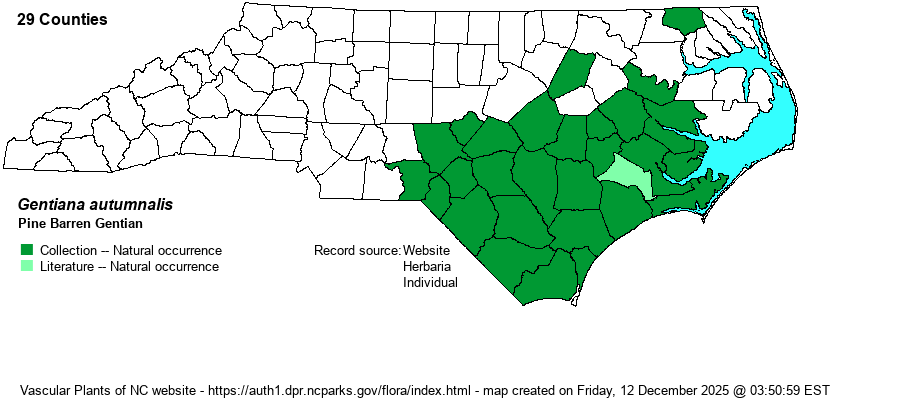| Author | L. | |
| Distribution | Throughout the southern 3/4ths of the Coastal Plain, plus a semi-disjunct record for Gates County along the VA border. Does not range into the Piedmont.
This is a mid-Atlantic Coast species, ranging from NJ south to eastern SC. Most populations are in NC and NJ. There is only one county record for VA. | |
| Abundance | Fairly common in the Sandhills region, as well as in the Longleaf Pine (Pinus palustris) belt from Craven County south to the SC line. Generally uncommon to infrequent in the rest of the Coastal Plain, other than very rare to absent in the northeastern portion. This species is not as scarce globally as NatureServe and some references would have you believe. Their Global Rank of G3 might look correct from the BONAP map, but as it is quite numerous and widespread in NC, certainly common enough to justify a State Rank of S4, such that the Global Rank should be G4. | |
| Habitat | This is a classic Longleaf Pine flatwoods and savanna species, but it also grows in the Sandhills region and elsewhere in various sandhills and other places in association with pinelands. Though most frequent in slightly moist or loamy sites, it can occur in dry to xeric pinelands. |
| Phenology | Blooms very late in the season, from late September into December, often not until late October or early November; fruits soon after flowering. | |
| Identification | This is a familiar species to NC biologists, at least those spending much time in the Coastal Plain. It is very different from the other gentians, having a slender stem with extremely narrow paired leaves. It grows to about 1.5 feet tall, but each of the several pairs of leaves is linear, 2-3 inches long and barely 1/10-inch wide. In fact, the stem and leaves are so thin that if the plant is not in bloom, you likely will overlook it. Thankfully, it has very large and bright flowers, one at the end of the stem, though some plants can have 2 or 3 flowers. Each is a deep blue to violet-blue, rather bell-shaped, with a wide open face/mouth and with 5 spreading lobes; each is nearly 2 inches long and almost as wide across. Sadly, many photographs in field guides and other books have the telltale purplish tint to them that is incorrect in life, as there is no red tint to the flowers -- they are violet-blue, deep blue, indigo blue, etc.! | |
| Taxonomic Comments | None, other than some older references naming it as G. porphyrio.
| |
| Other Common Name(s) | Autumn Gentian | |
| State Rank | S3 [S4] | |
| Global Rank | G3 [G4] | |
| State Status | | |
| US Status | | |
| USACE-agcp | FACW link |
| USACE-emp | FACW link |

